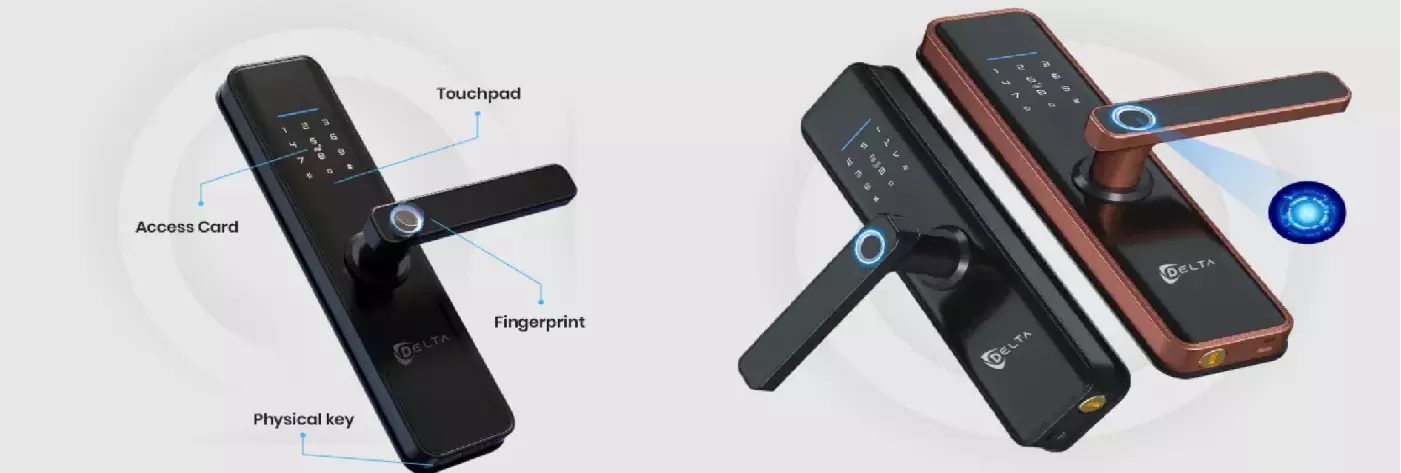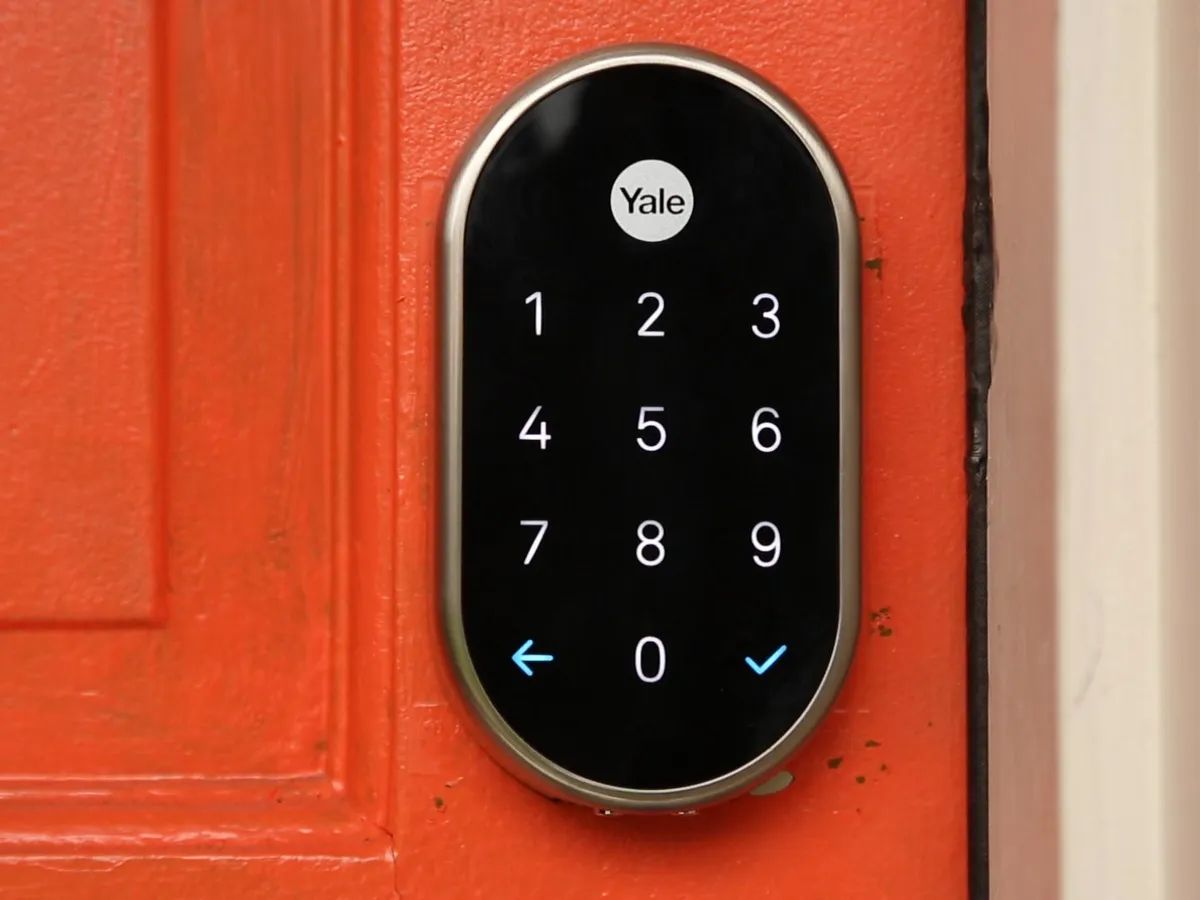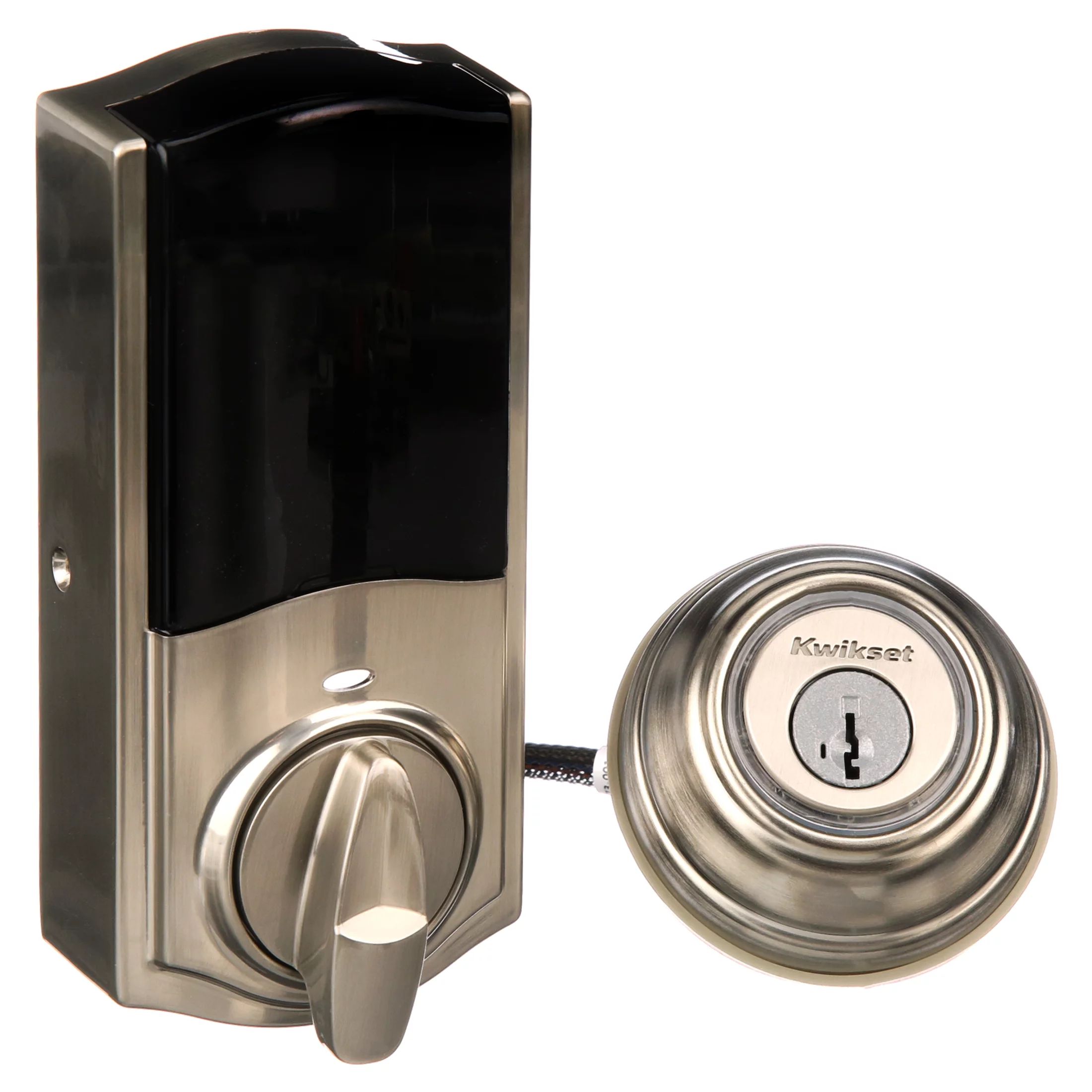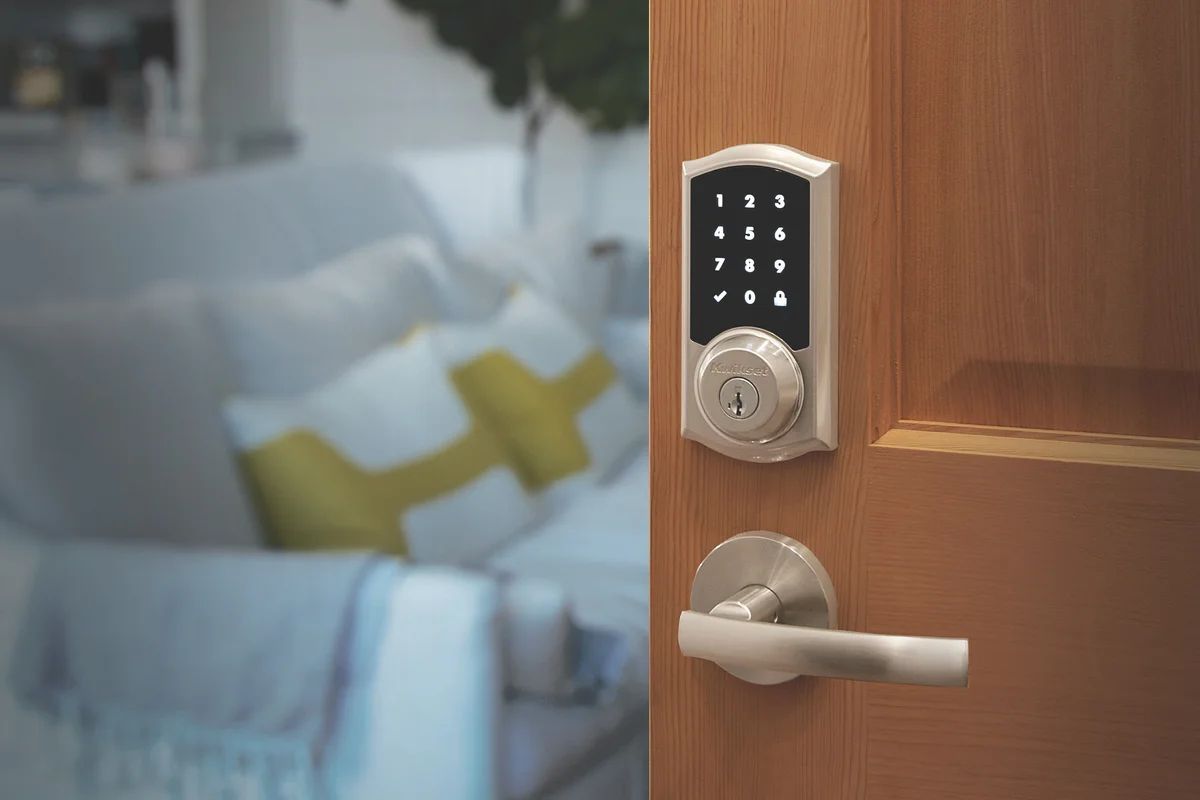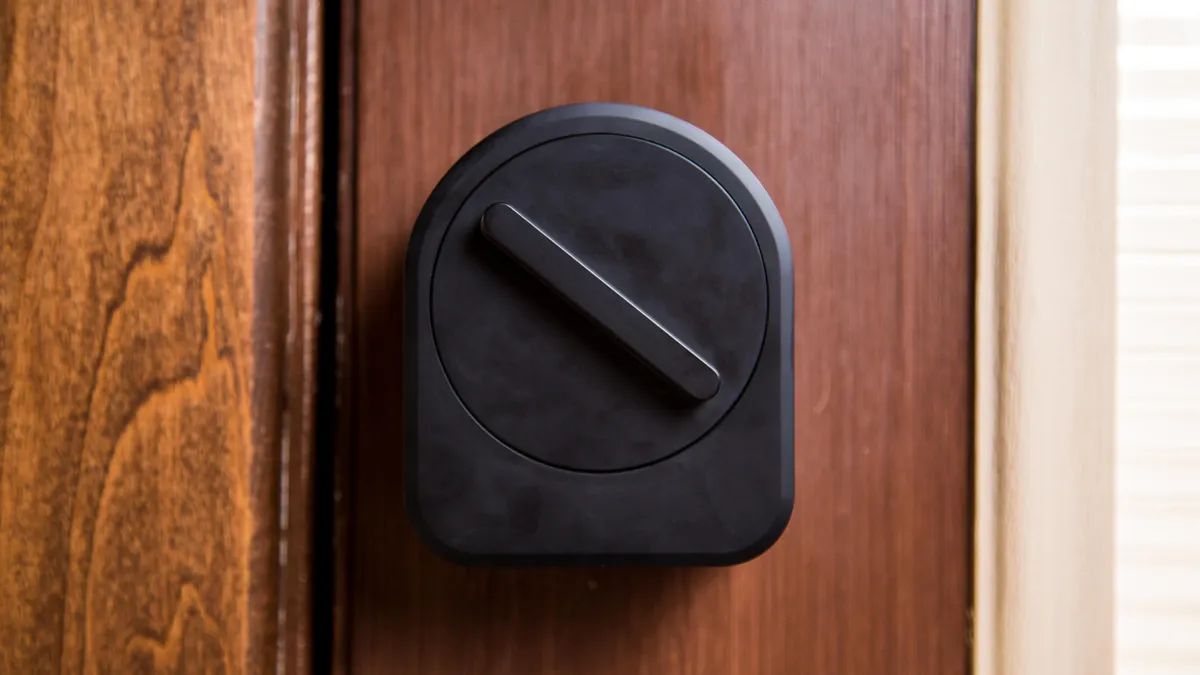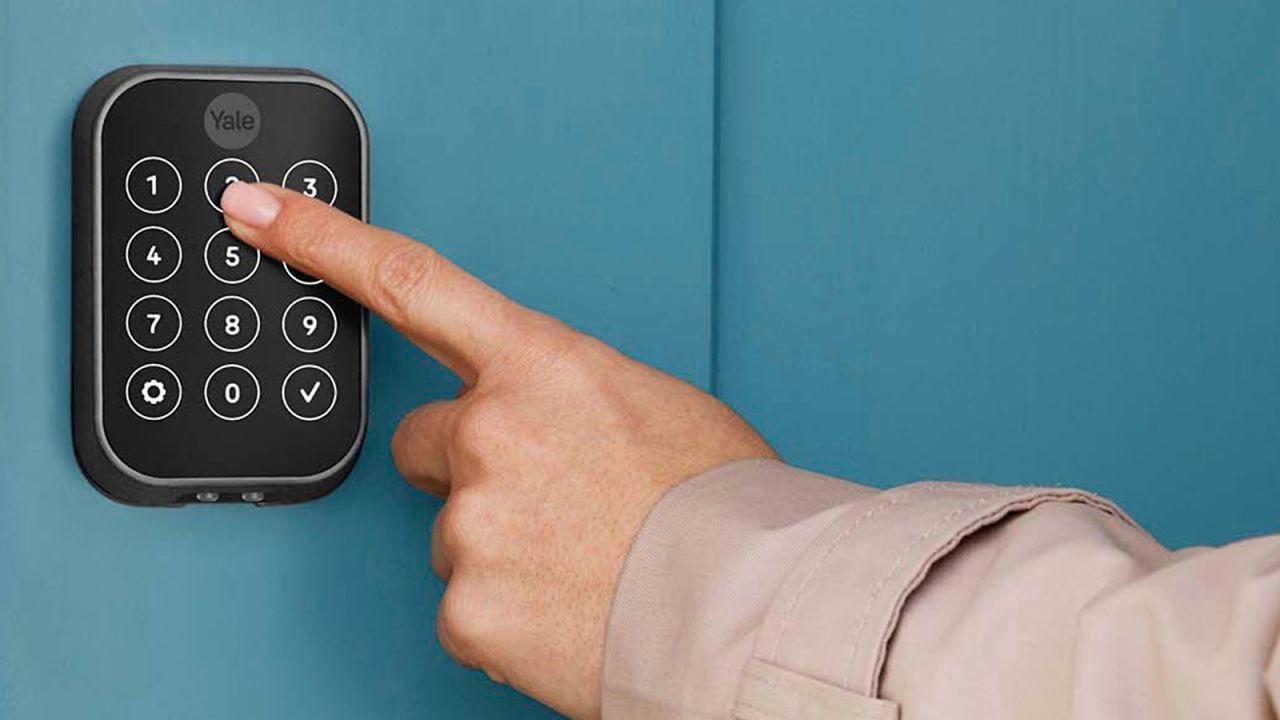Introduction
Welcome to the world of smart locks, where keys are a thing of the past and convenience and security go hand in hand. With advances in technology, traditional locks have been revolutionized, making way for smart locks that offer a plethora of benefits. Whether you’re a homeowner looking to upgrade your security or a tech-savvy individual interested in home automation, understanding how smart locks work is essential.
Smart locks are a modern solution that combines technology with traditional locking mechanisms, allowing you to lock and unlock your doors using your smartphone, voice commands, or other smart devices. These locks offer a seamless and convenient experience, replacing the need for physical keys. But how do they actually work?
In this article, we will delve into the intricacies of smart locks, exploring their components, communication mechanisms, authentication methods, and more. We will also discuss the advantages of using smart locks and touch upon important security considerations.
So, whether you’re a homeowner looking to enhance security or simply curious about the inner workings of smart locks, continue reading to discover the fascinating world of this innovative technology.
What is a smart lock?
A smart lock is a high-tech device that replaces the traditional lock and key system with a more advanced and secure method of accessing your home or property. It is an integral part of the growing smart home ecosystem, designed to offer convenience, flexibility, and enhanced security. Unlike conventional locks, smart locks can be controlled remotely, allowing you to lock and unlock your doors using a variety of methods.
Smart locks come in various forms and designs, but the underlying principle remains the same: to provide a keyless entry solution. They are typically equipped with advanced technology such as Bluetooth, Wi-Fi, or Z-Wave, which enables them to be connected to your smartphone, smart home hub, or other compatible devices. This connectivity allows you to control your lock remotely and receive real-time notifications about the status of your doors.
One of the key features of smart locks is their ability to provide multiple access options. Along with the traditional keyless entry through a pin code or a fingerprint scan, most smart locks can be controlled using a mobile app, voice commands, or even geo-fencing technology. This means you can unlock your door with a simple tap on your smartphone screen or by using your voice assistant, making it incredibly convenient, especially when your hands are full.
Another important aspect of smart locks is their compatibility with existing door hardware. They can be installed on most standard doors and are available in both retrofit and full replacement options. Retrofit smart locks can be easily installed onto your existing deadbolt, while full replacement locks require the entire lock mechanism to be replaced. Regardless of the type you choose, the installation process is typically straightforward and can be completed without professional assistance.
Overall, smart locks are a modern and secure alternative to traditional locks. They provide easy access control, seamless integration with smart home systems, and a range of features that enhance convenience and security. As the foundation of a smart home, smart locks pave the way for a more connected and intelligent living environment.
Benefits of using a smart lock
Smart locks offer a multitude of benefits that make them an attractive and practical solution for homeowners. From convenience to enhanced security, here are some of the key advantages of using a smart lock:
- Keyless entry: One of the primary benefits of smart locks is the elimination of physical keys. With a smart lock, you no longer have to fumble with keys or worry about lost or stolen keys. You can unlock your doors using a variety of methods such as your smartphone, a pin code, or even your fingerprint, providing a seamless and convenient access control solution.
- Remote access: Smart locks enable you to control and monitor your doors remotely. Whether you’re at work, on vacation, or simply away from home, you can use a mobile app to lock or unlock your doors. This is particularly useful if you need to grant access to family members, friends, or service providers when you’re not physically present.
- Integration with smart home systems: Smart locks seamlessly integrate with other smart home devices and systems. They can be connected to your smart home hub, allowing for automation and synchronization with other devices such as smart lights or security cameras. For example, you can program your smart lock to automatically lock the doors when you activate your home security system.
- Activity tracking: Many smart locks offer activity logs that allow you to monitor who enters and exits your home and at what times. This can provide valuable insights for security purposes or simply to track the comings and goings of household members. Some smart locks even send real-time notifications to your smartphone, keeping you informed about any activity at your front door.
- Temporary access: Smart locks give you the ability to grant temporary access to guests or service providers. Instead of handing out physical keys or leaving spare keys under the doormat, you can create unique pin codes or send digital invitations that expire after a specified period. This makes it easy to manage access and provides an added layer of security.
- Enhanced security features: Smart locks come equipped with advanced security features that improve the overall protection of your home. Many models have built-in tamper and forced entry detection, sounding alarms or sending alerts if someone attempts to tamper with the lock. Additionally, some smart locks offer geofencing capabilities, automatically locking the door when you leave the premises.
- Convenience: Smart locks make everyday life more convenient. Imagine never having to fumble for your keys again or worrying about forgetting to lock the door. With a smart lock, you can easily lock or unlock your doors with a simple tap on your smartphone or a voice command, saving you time and hassle.
These are just a few of the many benefits that come with using a smart lock. They offer a modern and secure way to control access to your home, providing convenience, peace of mind, and a sense of control over your security.
Components of a smart lock
A smart lock is a complex device that consists of several key components working together to provide secure and convenient access control. Understanding these components can give you a better grasp of how a smart lock functions. Here are the main components typically found in a smart lock:
- Locking Mechanism: The locking mechanism is the heart of a smart lock. It is responsible for securing the door and preventing unauthorized access. Most smart locks use a motorized or electromechanical locking mechanism that can be controlled remotely. This mechanism can be integrated with an existing deadbolt or can be a standalone lock.
- Connectivity Chip: To enable communication with other devices, smart locks are equipped with a connectivity chip. This could be Bluetooth, Wi-Fi, or Z-Wave, depending on the model. The connectivity chip allows the smart lock to connect to your smartphone, smart home hub, or other compatible devices, giving you the ability to control the lock remotely.
- User Interface: Smart locks have a user interface that allows you to interact with the lock, usually through a mobile app or a keypad. The mobile app provides a graphical interface on your smartphone, allowing you to lock or unlock the door, view activity logs, and customize settings. Keypad models have a physical numeric keypad where you can enter a pin code to unlock the door.
- Sensors: Smart locks incorporate various sensors to detect and monitor the status of the door. These sensors include position sensors that detect whether the door is open or closed, and tamper sensors that alert you if someone attempts to forcibly open or tamper with the lock. Some smart locks also have built-in motion sensors to trigger certain actions, such as automatically unlocking the door when you approach.
- Power Source: Smart locks require power to operate their electronic components. Most smart locks are battery-powered, often utilizing standard alkaline batteries. However, some models also offer options for hardwiring the lock to a power source. Battery life can vary depending on usage, but most smart locks come with low-battery indicators to alert you when it’s time to replace the batteries.
- Encryption and Security: Security is paramount in smart locks. To ensure the safety of your home, smart locks employ encryption protocols to protect communication between the lock and your smartphone or hub. This prevents unauthorized access and safeguards your personal information. Look for smart locks that employ industry-standard encryption methods to ensure your data is secure.
These are the primary components you will find in a smart lock. Each component plays a crucial role in the overall functionality of the lock, enabling secure and convenient access control for your home or property.
How does a smart lock communicate?
A key aspect of a smart lock’s functionality is its ability to communicate with other devices, such as your smartphone or smart home hub. This communication enables remote control and monitoring of the lock’s status. So, how exactly does a smart lock facilitate this communication? Let’s explore the various communication methods employed by smart locks:
- Bluetooth: Many smart locks utilize Bluetooth technology for communication. Bluetooth allows the smart lock to connect directly to your smartphone or other Bluetooth-enabled devices. Through a mobile app, you can send commands to the lock, such as locking or unlocking the door, as long as you are within the Bluetooth range, typically around 30-50 feet. Bluetooth communication is convenient and doesn’t rely on an internet connection, but it does have limitations in terms of range.
- Wi-Fi: Some smart locks incorporate Wi-Fi connectivity, which offers greater range and flexibility. These locks connect directly to your home Wi-Fi network, allowing you to control and monitor them from anywhere as long as you have an internet connection. This means you can lock or unlock your doors even when you’re away from home. Wi-Fi-enabled smart locks often have their own dedicated mobile app or can be integrated into a larger smart home system.
- Z-Wave: Z-Wave is a wireless communication protocol specifically designed for home automation devices. Smart locks equipped with Z-Wave technology can communicate with other Z-Wave-enabled devices in your smart home system. These locks act as a node in a mesh network, relaying signals to enhance range and coverage. Z-Wave offers secure and reliable communication, but it requires a separate Z-Wave hub or controller to facilitate the communication between the lock and your smartphone or other devices.
- HomeKit and Zigbee: Some smart locks are compatible with popular smart home platforms, such as Apple HomeKit or Zigbee. These platforms provide a standardized communication framework, allowing seamless integration with other compatible devices. If you have a smart home hub that supports these protocols, you can control your smart lock alongside other devices using a single app or voice commands through a voice assistant like Apple’s Siri or Amazon’s Alexa.
Regardless of the communication method used, smart locks securely transmit data between the lock and the controlling device. The communication is typically encrypted to ensure the integrity and privacy of the data. Depending on the smart lock model and features, you may also receive real-time notifications on your smartphone, keeping you informed about the status of your lock and any activity at your front door.
Considering your needs and the compatibility with your existing devices and smart home system, it’s important to select a smart lock that utilizes a communication method that suits your requirements and offers optimal convenience and control.
How does a smart lock authenticate users?
Authentication is a critical element of smart lock technology, ensuring that only authorized individuals can access your home or property. Smart locks employ various methods to authenticate users and verify their identity. Let’s explore some of the common authentication methods used by smart locks:
- Mobile Apps: Many smart locks utilize mobile apps as the primary authentication method. The mobile app acts as a gateway, allowing you to control and manage the lock. To authenticate, you typically need to provide a password or PIN code to access the app. Once authenticated, you can remotely lock or unlock the door, monitor activity, and customize settings. Mobile app authentication combines convenience with security, as you can use biometric authentication, such as fingerprint recognition or facial recognition, if supported by your smartphone.
- Keypad Entry: Smart locks equipped with a built-in keypad allow users to enter a unique PIN code to unlock the door. Each user can have their own personalized code, which can be easily added or revoked as needed. Keypad entry is convenient for family members, guests, or service providers who may not have a smartphone or need temporary access. However, it’s important to choose a secure PIN code and avoid easily guessable combinations.
- Biometric Authentication: Some advanced smart locks offer biometric authentication methods, such as fingerprint recognition or facial recognition. These methods provide high-level security, as they use unique physical traits to verify identity. Biometric authentication ensures that only approved individuals who possess the registered biometric characteristics can access the lock. It offers a seamless and convenient way to authenticate, eliminating the need for keys, codes, or mobile apps.
- Proximity Devices: Smart locks can also authenticate users based on the proximity of their devices. For example, if you have your smartphone with you, the smart lock can automatically detect the presence of your device and unlock the door when you approach. This method, known as geofencing or proximity-based authentication, offers a hands-free experience and reduces the need for manual authentication.
- Additional Security Measures: Alongside the primary authentication methods, smart locks may incorporate additional security measures to enhance the authentication process. These can include two-factor authentication, where users need to verify their identity through multiple methods, such as a PIN code and a fingerprint scan. Some smart locks may also have built-in cameras or face recognition features to verify the identity of individuals attempting access.
It’s important to note that different smart locks may offer different authentication methods. The choice of authentication method depends on the capabilities of the lock, your individual preferences, and the desired level of security. By implementing multi-factor authentication and utilizing secure and unique credentials, smart locks ensure that only authorized users can gain access.
The role of encryption in smart locks
Encryption plays a crucial role in the security of smart locks, ensuring the confidentiality and integrity of the data transmitted between the lock and other connected devices. Smart locks employ encryption protocols to safeguard the communication and prevent unauthorized access. Let’s explore the importance of encryption in smart locks and how it contributes to their overall security:
Data Security: Encryption protects sensitive data, such as passwords, authentication credentials, and communication between the smart lock and your smartphone or smart home hub. It prevents unauthorized individuals from intercepting and deciphering this data, ensuring that only authorized parties can access and control the lock.
Confidentiality: Encryption ensures the confidentiality of your personal information. It prevents attackers from eavesdropping on the communication between the lock and your devices, keeping your data private and secure.
Secure Authentication: Encryption plays a vital role in ensuring the security of authentication processes. When you enter a PIN code or use biometric authentication methods, encryption protocols help protect this information during transmission. This makes it incredibly difficult for attackers to intercept and use this data maliciously.
Protection Against Tampering: Encryption provides protection against tampering attempts. A well-implemented encryption mechanism helps detect any unauthorized modification or tampering of the data transmitted between the smart lock and connected devices. If tampering is detected, the encryption protocols can prevent the compromised data from being accepted or acted upon.
Secure Remote Access: Encryption is particularly important in the case of remote access to smart locks. When you control and monitor your smart lock from a remote location, encryption ensures that your commands and the status updates of the lock are securely transmitted over the internet. This protects your data from interception or unauthorized access while providing you with remote control capabilities.
Industry-Standard Encryption: To ensure the effectiveness of encryption in smart locks, it is recommended to choose locks that employ industry-standard encryption methods. These methods, such as Advanced Encryption Standard (AES) or Secure Sockets Layer (SSL)/Transport Layer Security (TLS) protocols, have undergone extensive security testing and are widely accepted as secure encryption standards.
It’s crucial to note that no encryption method is completely foolproof. However, by implementing robust encryption protocols, smart locks significantly enhance the overall security and protect against various forms of cyberattacks, such as eavesdropping, data interception, and unauthorized access.
When choosing a smart lock, it is important to consider the encryption capabilities and the security measures implemented by the lock manufacturer. By selecting a smart lock with strong encryption and built-in security features, you can have peace of mind knowing that your smart lock is safeguarded against potential security risks.
How does a smart lock unlock?
Unlocking a smart lock is a seamless and convenient process that eliminates the need for physical keys. Smart locks offer various methods of unlocking, depending on the model and its capabilities. Let’s explore some of the common ways in which a smart lock can be unlocked:
- Mobile App: The most common method of unlocking a smart lock is through a dedicated mobile app. Once the smart lock is connected to your smartphone via Bluetooth, Wi-Fi, or other communication protocols, you can simply open the mobile app and send a command to unlock the door. This allows you to remotely control the lock and grant access to yourself or others from anywhere, as long as you have an internet or Bluetooth connection.
- Keypad Entry: Smart locks equipped with a built-in numeric keypad allow for entry of a personalized PIN code to unlock the door. Each user can have their own unique code, which can be easily added or revoked as needed. Keypad entry is convenient for family members, guests, or service providers who may not have access to a smartphone or require temporary access.
- Voice Commands: Voice assistants, such as Amazon’s Alexa or Google Assistant, can be integrated with smart locks. With voice commands, you can instruct the voice assistant to unlock the door using a pre-defined passphrase or by providing authentication through your voice. This hands-free method offers convenience and quick access to your home.
- Proximity Devices: Some smart locks support proximity-based unlocking. This method relies on the presence of a device, typically a smartphone or a connected key fob. When the authorized device comes within a certain range of the lock, it automatically detects the proximity and unlocks the door. Proximity-based unlocking offers a hands-free experience and eliminates the need for manual authentication.
- Biometric Authentication: Advanced smart locks incorporate biometric authentication methods, such as fingerprint recognition or facial recognition. Users can register their biometric data in the lock’s system, and upon authentication, such as a fingerprint scan, the lock automatically unlocks. Biometric authentication ensures a high level of security and offers a convenient and seamless unlocking experience.
It’s important to note that the available unlocking methods may vary depending on the smart lock model and its specific capabilities. Some locks may offer a combination of these methods, allowing you to choose the most suitable method for your needs and preferences.
In terms of security, smart locks implement various measures to ensure that unauthorized access is prevented. This includes encrypted communication, secure authentication protocols, and tamper detection. By utilizing these technologies, smart locks provide a reliable and secure way to unlock your doors while enhancing convenience and peace of mind.
How are smart locks powered?
Smart locks require a power source to operate their electronic components, which enable the various features and functionalities. Let’s take a closer look at the different methods of powering smart locks:
- Battery-Powered: The most common power source for smart locks is batteries. Smart locks are designed to be energy-efficient, allowing them to operate on battery power for an extended period. The type of batteries required can vary between different smart lock models. Alkaline batteries, such as AA or AAA, are commonly used and easily replaceable. Some smart locks may also have built-in rechargeable batteries that can be powered up using a USB cable or a charging dock.
- Hardwired: Some smart locks can be directly hardwired into your home’s electrical system. This eliminates the need for batteries and ensures a constant power supply to the lock. Hardwired smart locks typically require professional installation to connect them to the electrical circuit. It’s important to consult an electrician if you are considering this option.
- Hybrid Solution: Certain smart locks offer a hybrid solution, combining battery power with the option for hardwired connection. This allows you to use batteries as the primary power source for everyday operation, while providing the ability to connect to an electrical power source when available. The hybrid approach provides added flexibility and ensures that the lock remains functional even if there is a temporary power outage or a drained battery.
Regardless of the power source used, smart locks typically come equipped with low-battery indicators. These indicators alert you when the battery level is running low, prompting you to replace or recharge the batteries in a timely manner. This ensures that your smart lock remains operational and eliminates the risk of being locked out due to a dead battery.
It’s important to note that the lifespan of battery-powered smart locks can vary depending on the frequency of usage, the number of connected devices, and the overall power consumption of the lock. Manufacturers often provide information on estimated battery life based on typical usage patterns. Regularly replacing the batteries or charging them as needed will ensure the continuous and reliable performance of your smart lock.
When choosing a smart lock, consider your preferred power source, budget, and the convenience of accessing and replacing the batteries. Understanding the power requirements of the smart lock will help you select the most suitable and reliable option for your needs.
Integration with smart home systems
Smart locks are designed to seamlessly integrate with other smart home devices and systems, enhancing the overall functionality and convenience of your home automation setup. Let’s explore how smart locks can be integrated into a smart home system:
Smart Home Hubs: Smart locks can be connected to a central smart home hub that acts as a control center for all your smart devices. These hubs, such as Amazon Echo Plus, Samsung SmartThings, or Google Nest Hub, provide a unified platform to manage and monitor your smart lock alongside other connected devices. You can use a single app or voice command to control and access various aspects of your smart home system.
Mobile Apps: Most smart locks come with their own dedicated mobile app that allows you to control and manage the lock. These apps often offer additional features and customization options beyond basic lock/unlock functionality. Through the app, you can grant temporary access, track activity logs, receive notifications, and customize settings according to your preferences. Some smart lock apps even allow you to integrate with other smart home devices for a more comprehensive control experience.
Automation Routines: Smart locks can be incorporated into automation routines or rules within your smart home system. For example, you can set your lock to automatically lock the door when you activate your home security system or when everyone leaves the house. This ensures that your home is always secure, even if you forget to lock the door manually.
Customized Access: Integrating your smart lock with other smart home devices allows for customized access control based on specific conditions or triggers. For instance, you can program your smart lock to grant access to a delivery person temporarily when the motion sensor of your doorbell camera detects package delivery. Once the delivery is complete, the access is automatically revoked.
Voice Control: Integration with voice assistants, such as Amazon Alexa, Google Assistant, or Apple Siri, offers hands-free control over your smart lock. You can use voice commands to lock or unlock the door, check the lock status, or create custom voice routines. This voice control integration provides convenience and accessibility, particularly when your hands are full or when you are away from your smartphone.
Integrating your smart lock with a smart home system enables a more cohesive and streamlined experience, where you can control multiple devices and automate various functions within your home. Whether it’s managing access, enhancing security, or creating personalized routines, the integration of smart locks with other smart home devices expands the possibilities of what you can achieve with your home automation setup.
Security considerations for smart locks
While smart locks offer enhanced convenience and access control, it’s essential to prioritize the security of your home when choosing and using these devices. Here are some key security considerations to keep in mind:
Encryption and Data Security: Ensure that the smart lock employs strong encryption protocols to protect communication between the lock and your smartphone or other devices. Look for locks that use industry-standard encryption methods, such as Advanced Encryption Standard (AES) or Secure Sockets Layer (SSL)/Transport Layer Security (TLS). This helps keep your data secure and prevents unauthorized access to your smart lock.
Password Management: Choose a strong and unique password for the mobile app or any other account associated with your smart lock. Avoid using easily guessable passwords and consider enabling two-factor authentication for an added layer of security. Regularly update your passwords and avoid sharing them with unauthorized individuals.
Firmware Updates: Keep your smart lock’s firmware up to date by installing any available updates provided by the manufacturer. Firmware updates often address security vulnerabilities and add new features or improvements to your smart lock. Regularly checking for updates ensures that you have the latest security patches and helps maintain the integrity of your smart lock’s functionality.
Manufacturer Reputation: Choose a reputable and well-established manufacturer when selecting a smart lock. Research the manufacturer’s reputation for security and privacy practices to ensure they prioritize customer data protection and product security. Reviews and recommendations from trusted sources can help guide your decision-making process.
Physical Security Measures: While the focus is often on digital security, don’t overlook the physical security measures of your smart lock. Ensure that the lock’s physical components, such as the locking mechanism and housing, are made of durable materials and provide resistance against tampering or physical attacks. Properly install the lock according to the manufacturer’s instructions to maximize its effectiveness.
Regular Monitoring and Auditing: Take advantage of the logging and activity monitoring features provided by your smart lock. Regularly review activity logs to ensure that only authorized individuals access your home and detect any suspicious or unauthorized access attempts. Enable notifications for lock events, such as lock/unlock alerts, to stay informed about the status of your smart lock and any activity at your front door.
Secure Network and Device Management: Ensure that your home Wi-Fi network is secure by using a strong, unique password and enabling encryption protocols (e.g., WPA2 or WPA3). Regularly update the firmware of your connected devices, including your smartphone and smart home hub, to protect against potential security vulnerabilities. Keep your devices locked with a secure PIN or biometric authentication, and be cautious of granting permissions to unknown apps or services.
By considering these security measures, you can enhance the overall security of your smart lock and minimize potential risks associated with unauthorized access or cyber threats. Taking proactive steps to protect your smart lock and incorporating best practices for digital and physical security will help ensure a safe and secure home environment.
Conclusion
Smart locks have transformed the way we secure and access our homes. With their innovative features and seamless integration with smart home systems, these advanced locks provide convenience, control, and enhanced security. By using various authentication methods, such as mobile apps, keypads, biometric recognition, and proximity devices, smart locks offer keyless entry solutions tailored to individual preferences and requirements.
From remote access and temporary access capabilities to integration with smart home hubs and voice assistants, smart locks have become an integral part of the broader smart home ecosystem. They provide an added layer of convenience, allowing homeowners to manage their locks from anywhere, track user activity, and automate access routines, all with the assurance of robust encryption and data security.
When considering a smart lock for your home, it is crucial to prioritize security. Look for locks that employ strong encryption protocols, regularly update firmware, and choose reputable manufacturers who prioritize customer data protection. Additionally, implement best practices, such as using unique passwords, enabling two-factor authentication, and regularly monitoring and auditing lock activity.
With the rapid advancement of smart home technology, the future of smart locks holds even more exciting possibilities. Integration with artificial intelligence, machine learning, and other emerging technologies will continue to advance the functionality and security of smart locks, making them even more convenient and reliable for homeowners.
In conclusion, smart locks offer a modern, secure, and convenient alternative to traditional locks. By leveraging cutting-edge technology, these locks provide a heightened level of control, accessibility, and peace of mind. Whether you’re looking to upgrade your security, streamline access for your family and guests, or integrate your lock into a larger smart home system, a smart lock can revolutionize the way you secure and interact with your home.







